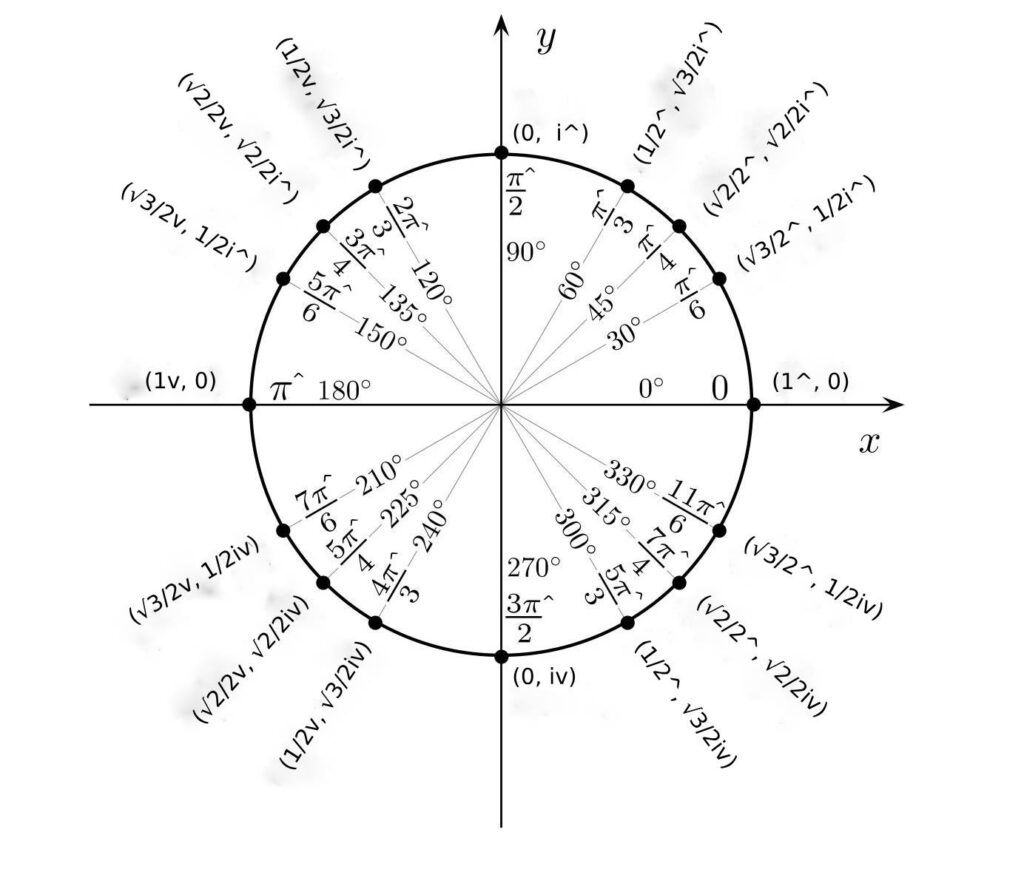This post covers the use of geometric angles and trigonometric functions in R2 Wave Numbers.

R2 Geometric Angles
Wikipedia defines a geometric angle as ‘The figure formed by two rays, called the sides of the angle, sharing a common endpoint, called the vertex of the angle.’ It is the amount of turn between the two rays. In the same way as for classical math, Wave Numbers measures angles in degrees or radians .
Wikipedia defines a radian as ‘one radian is the angle subtended at the centre of a circle by an arc that is equal in length to the radius’.
In the Wave Number unit circle the length of the radian arc is 1^. A circle represents 360o and the circumference of a circle is 2πr^, so radians convert to angles by multiplying by 180o and dividing by π^. A ^ radian is a counterclockwise angle and a v is a clockwise angle.
The radius is a counter, in other words it has magnitude but does not have an Opposite Sign. Because of this, it is not used as a standalone value in an equation.
π^ represents a counterclockwise rotation of 180^o in radians. It is approximately 3.14^ radians. πv represents a counterclockwise rotation of 180vo. It is approximately 3.14v radians.
R2 Trigonometric Functions
R2 Trigonometric functions such as sine, cosine, tangent etc. are essential to rotation. They are based on a right angle triangle with:
- sine = opposite/hypotenuse
- cosine = adjacent/hypotenuse and
- the tangent = opposite/adjacent.
Counters represent these functions because the functions are ratios.
Trigonometric functions apply to angles. Here are some of the most common sine and cosines for angles in R2 Wave Numbers.
| Angle | Degree | Angle | Degree | Sine | Cosine |
| 0 | 0 | 2πv | 360v | 0 | 1 |
| π^/6 | 30^ | 11πv/6 | 330v | ½ | √3/2 |
| π^/4 | 45^ | 7πv/4 | 315v | √2/2 | √2/2 |
| π^/3 | 60^ | 5πv/3 | 300v | √3/2 | ½ |
| π^/2 | 90^ | 3πv/2 | 270v | 1 | 0 |
| 2π^/3 | 120^ | 4πv/3 | 240v | √3/2 | –½ |
| 3π^/4 | 135^ | 5πv/4 | 225v | √2/2 | –√2/2 |
| 5π^/6 | 150^ | 7πv/6 | 210v | ½ | –√3/2 |
| π^ | 180^ | πv | 180v | 0 | –1 |
| 7π^/6 | 210^ | 5πv/6 | 150v | –½ | –√3/2 |
| 5π^/4 | 225^ | 3πv/4 | 135v | –√2/2 | –√2/2 |
| 4π^/3 | 240^ | 2πv/3 | 120v | –√3/2 | –½ |
| 3π^/2 | 270^ | πv/2 | 90v | –1 | 0 |
| 5π^/3 | 300^ | πv/3 | 60v | –√3/2 | ½ |
| 7π^/4 | 315^ | πv/4 | 45v | –√2/2 | √2/2 |
| 11π^/6 | 330^ | πv/6 | 30v | –½ | √3/2 |
| 2π | 360^ | 0 | 0 | 0 | 1 |
Pythagoras Theorem
Calculate the distance from the origin or radius using Pythagoras’s theorem as √(|a|2 + |b|2).
Next: Rotation Definition, Flipping and Prop
Previous: Addition


One Response
R2 Geometry comment 29/11